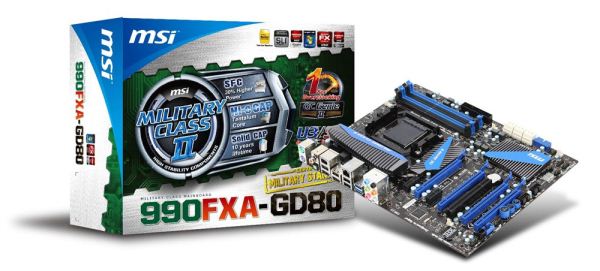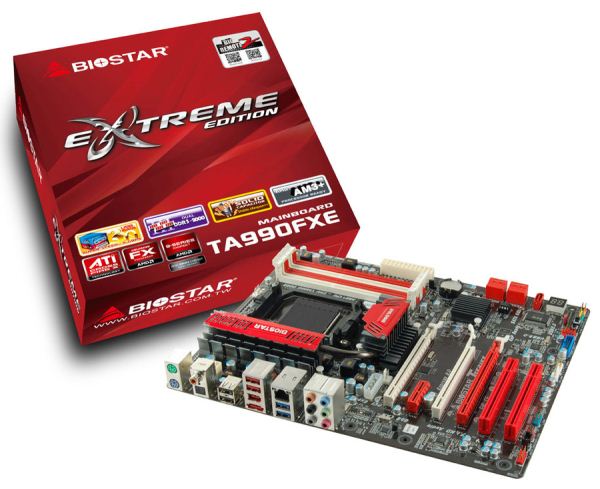990FX Motherboard Roundup with Thuban and Bulldozer – A Second Wind for ASUS, Gigabyte, MSI and Biostar
by Ian Cutress on April 5, 2012 11:00 AM ESTMSI 990FXA-GD80
When considering the MSI 990FXA-GD80 as a product to purchase, it comes with its highs and its lows. On the bright side, we have a good performing system that comes with a mountain of extras in the box compared to other products, and the BIOS is a great system. However, it becomes slightly negative if you want to overclock a Bulldozer, or want any distinct control over the fans.
Users should update their launch BIOSes to F5 or later to take advantage of that new BIOS system, and flashing the BIOS is very simple through the Live Update 5 software provided. Unfortunately the BIOS does not show the user what is auto for voltages, so a little insight is needed when changing these options. There was also a minor problem with my AMD 5850 graphics cards, spinning up to 100% for a few seconds after boot, but this did not happen with my NVIDIA 580 test cards.
Performance wise, nothing stuck out like a sore thumb and the MSI 990FXA-GD80 kept up in pace with the other products we have tested.
For $195, and the bonus in the box, the MSI 990FXA-GD80 is a nice board to run at stock, or a good one to have with a Thuban based processor.
Biostar TA990FXE
As the cheapest board in our test, it was fair to assume that perhaps the TA990FXE would not amount to much when in came to a direct comparison with the other boards in this review - with $50-$100 difference, it was to be expected. On some levels of testing, it shows - the layout isn't optimal, the DPC Latency is hideous compared to the other boards, there are not many fan headers and there is an odd choice of network controller.
However, the Biostar TA990FXE came across as pleasantly surprising. The BIOS works well (even if the options are sometimes in confusing places), it overclocks Bulldozer on par or better than some of the other boards and comes with more kit in the box than expected.
Performance wise it doesn't break into the top half much when discussing CPU benchmarks, however it has a relatively decent showing in the GPU benchmarks. Essentially, this is a board for people who just need something cheap to run their processor. It fits that niche quite well, especially if you only have one GPU and need a PCI slot or two.
While the Biostar TA990FXE isn't the best board in the world, and it could use a little insight and design change to be consumer optimal, it is a cheap board that works.
Conclusion
This combination review has been a long time coming, repetitively pushed back by other releases or events. However we have now crossed through the land of 990FX, examining boards ranging from $130 to $215, and there is a lot to choose from.
Each of the boards can be separated by styling, by BIOS function, any by software utilities. As a direct minor evolution of the 8-series for Bulldozer, it does seem amazing that some motherboards really take to Bulldozer like an old friend, while others prefer it left alone running at stock speeds.
Each board can have its own minor flaws; however one major flaw comes across most of the range - about which CPU temperature sensor to believe when it comes to determining fan speeds. Using HWMonitor, on some motherboards it would report ~14ºC at idle and the CPU fan would be slow, and on others it would be around 30ºC, a more realistic number. This all comes down to whether the system will read the onboard CPU temperature, or a different sensor placed on the board specifically for reporting different temperatures.
This aside, each board has its plus points. If I was a gamer, the ASUS ROG Crosshair V Formula would be my major priority - as it was the board AMD prioritized for Bulldozer release, it is tweaked to run as best as it can. For fan control and performance, nothing comes close to the ASUS Sabertooth 990FX. The Gigabyte 990FXA-UD5 took advantage of that alternative CPU temperature reading and reduced my CPU fan to off or almost off at idle, resulting in a near silent system. The MSI 990FXA-GD80 performs well with a Thuban and provides a nifty USB 3.0 bracket in the box. The Biostar TA990FXE represents full sized ATX on a budget with AMD that is easy to update. If I were to take one, money no object, then I would plunge for one of the ASUS boards.












57 Comments
View All Comments
IanCutress - Thursday, April 5, 2012 - link
Unfortunately we don't have an infinite amount of kit to review with. We're individual reviewers here, not all working in a big office. Obviously we can't all request top end kit from manufacturers either. Plus for every time we do use new high end kit, we also get comments about testing something 'more realistic' to most users. In that circumstance, we can't win and please everyone, but we do try and be as consistent as possible.Ian
phocean - Thursday, April 5, 2012 - link
I bought the Sabertooth a few weeks ago... and it throws an annoying buzzing sound in the speakers, especially when a USB port is used (in other words, all the time).It is the sign of an isolation issue between chipsets and shows poor design and testing from Asus.
Needless to say that the support was of no help (and no willing to help).
So don't buy it, unless you don't plug any speaker in it.
richaron - Friday, April 6, 2012 - link
Mine doesn't have this problem. You either got an unlucky board, or your psu is funky.extide - Thursday, April 5, 2012 - link
Seem to me like you were probably using a bit too much voltage for the BD. I would assume that is why you had so many issues with thermal runaway. 1.4-1.45ish would probably be a better place to stay with an air cooler :)extide - Thursday, April 5, 2012 - link
EDIT: Nevermind I forgot you are using the AMD kit watercooler, which is better than straight air cooling but I'd think it would take more of a fully custom built water setup to run 1.5v vCore.Hrel - Thursday, April 5, 2012 - link
I was going to build a new computer based on Ivy Bridge this Fall, I'm still running a Core 2 Duo E8400. But I've decided I'm not building myself a new computer until the motherboard has USB 3.0 and ONLY USB 3.0. A LOT of them, EVERYWHERE!I just built a guy a Z68 based computer with an i7 2700K but I had to order a VERY hard to find adapter card to plug in the USB 3.0 based memory card reader and the USB 3.0 on the front of the Fractal Design case. Because the Asus motherboard has ZERO USB 3.0 headers on it. It never even occurred to me that was a possibility. Not only has USB 3.0 been out for years now, but it was released WAY over-due. WTF is the hold up. Make the switch. USB 2.0 is for the 2000's decade, it's 2012. I am done with USB 2.0. I shouldn't have to buy an add-in card for BRAND NEW motherboard to support basic accesories, like a memory card reader and front usb port.
This is related to this article because I think if AMD was actually competitive with Intel AT ALL, like they were with Athlon XP/64/64 X2, then Intel would step up their game all around. Or maybe I wouldn't even have to buy Intel because they constantly make shit decisions like this, and changing the motherboard socket constantly, and charging 300 dollars for a quad core with HT. Their shit is endless and I really don't want to buy their products but AMD is simply not an option; if I wanted something that slow I'd just put a quad core Penryn based CPU in my current rig and save a bunch of money.
ggathagan - Friday, April 6, 2012 - link
There are only two Asus Z68 boards that don't have the USB 3 header, but somehow it's *Intel's* fault that Asus didn't use a USB 3 header on the board you bought?Huh...
Maybe you should have been a little more attentive when board shopping.
IanCutress - Friday, April 6, 2012 - link
Hi Hrel,I actually like USB 2.0 on my boards. If you have solely USB 3.0 and use them all, there's a big chance of a bottleneck in the bus somewhere. Also, I install a fresh operating system on every board I test via USB as it is a lot quicker than CD. Unfortunately during the install program, it doesn't process anything through the USB 3.0 ports - mouse, keyboard, or even the USB stick with the OS on. So I ideally like to have three USB 2.0 ports for that purpose. It's more a fault of Windows7 than the chipset, but otherwise if a board only has two USB 2.0 ports, I have to disconnect the mouse and use the keyboard and USB install drive only. Saying that, I have a board in that is solely USB 3.0, so it's going to be fun to install an OS on that... :/
Ian
fic2 - Friday, April 6, 2012 - link
I have a Dell keyboard that has 2 USB ports on it. That would solve your problem with a 2 x USB 2 mb. I currently have the mouse daisy chained off the keyboard.B - Thursday, April 5, 2012 - link
Your article should note that sound blaster provides a software overlay, but under that aluminum skin overlay lies a Realtek chip. I was fooled by this marketing and very disappointed after configuring this motherboard and discovering this fact. You don't get soudblasters hardware acceleration or the crystalizer. You should note this in any article about the asus line with x-fi2. Had I known I would have done things differently.